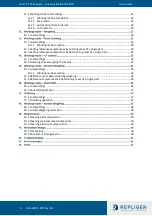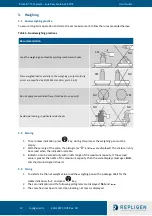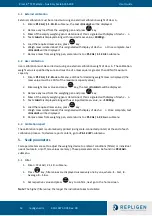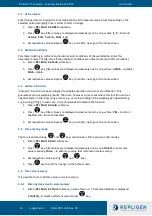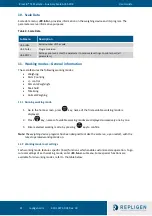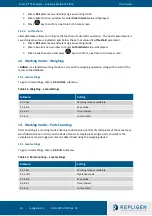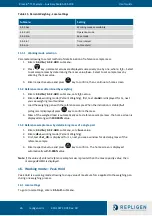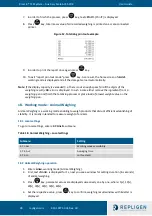
KrosFlo® TFF System
–
Auxiliary Scale ACSS-20K
User Guide
13 repligen.com 420-14871-001 Rev. 00
4.
Taring can be carried out repeatedly within the whole weighing range. Do not exceed the
maximum capacity, i.e. sum of tare weight value and load weight value must be lower than
the maximum capacity value.
5.
Upon unloading, the sum of tared masses with a minus sign is displayed. To return to zero
point press
key.
3.3.1
Entering tare value manually
1.
Press
and
keys combination, tare value edit box is displayed.
2.
Enter tare value. To do so press
to set digit value (0 - 9) and
to select digit to be
edited.
3.
Press
key to confirm, the scale returns to the weighing mode, modified tare value with
‘
-
‘ sign is di
splayed.
4.
You can enter tare value at any time during the weighing operation.
3.4
Units
<P9.Unit>
parameter group enables change of start unit and temporary unit. The units can be
changed during weighing or during other working modes operation. ‘Parts
Coun
ting’ and ‘Percent
W
eighing’ modes are exceptions.
3.4.1
Start unit
1.
Enter
<P9.Unit/9.1.UnSt>
submenu.
2.
Press
key, available units are displayed successively one by one. Available units are:
g (gram), kg (kilogram), ct (carat), lb (pound).
3.
Select start unit and press
key. To return to home screen press
key.
4.
Upon restart, the scale runs with the set start unit.
3.4.2
Temporary unit
Temporary unit runs from the moment it is set to the scale shut-down and restart.
1.
Enter
<P9.Unit/9.2.Unin>
submenu.
2.
Press
key, available units are displayed successively one by one. Available units:
g (gram), kg (kilogram), ct (carat), lb (pound).
3.
Select start unit and press
key. To return to home screen press
key.
4.
Calibration
In order to ensure the highest weighing accuracy, it is recommended to periodically introduce
corrective factor of indications to scale memory. This factor is a known reference weight which is
used to perform a calibration of the scale.
Calibration is recommended to be carried out when:
1.
Prior to weighing.
2.
If long breaks between successive measuring series occurs.
3.
If the ambient temperature has changed dynamically.
4.
If the scale has been relocated.




